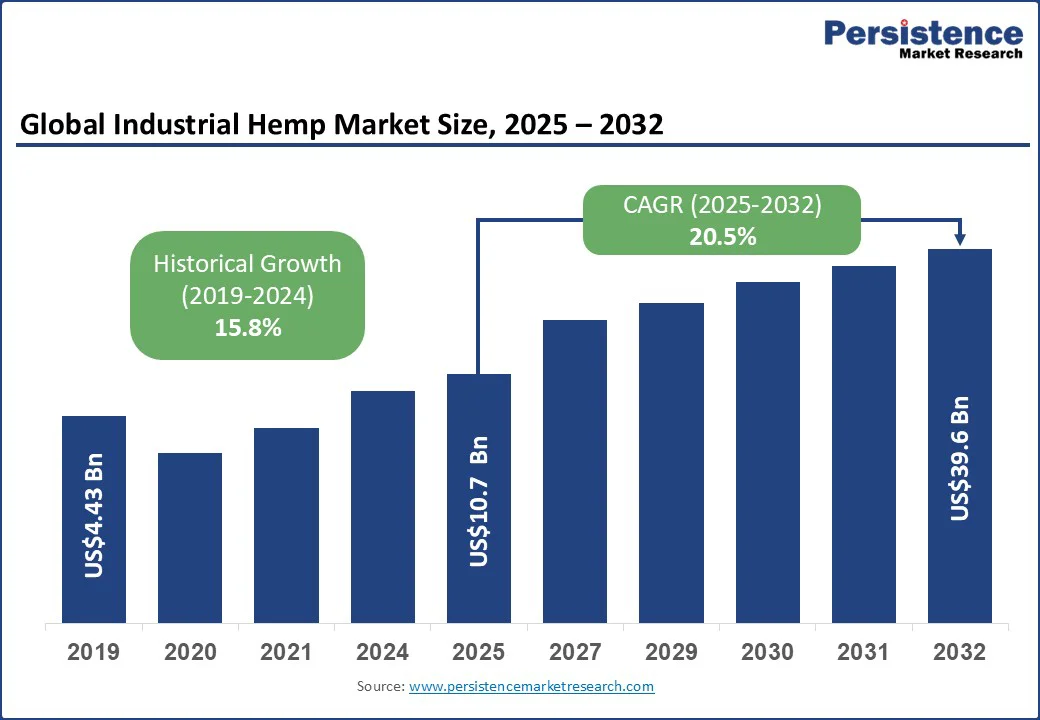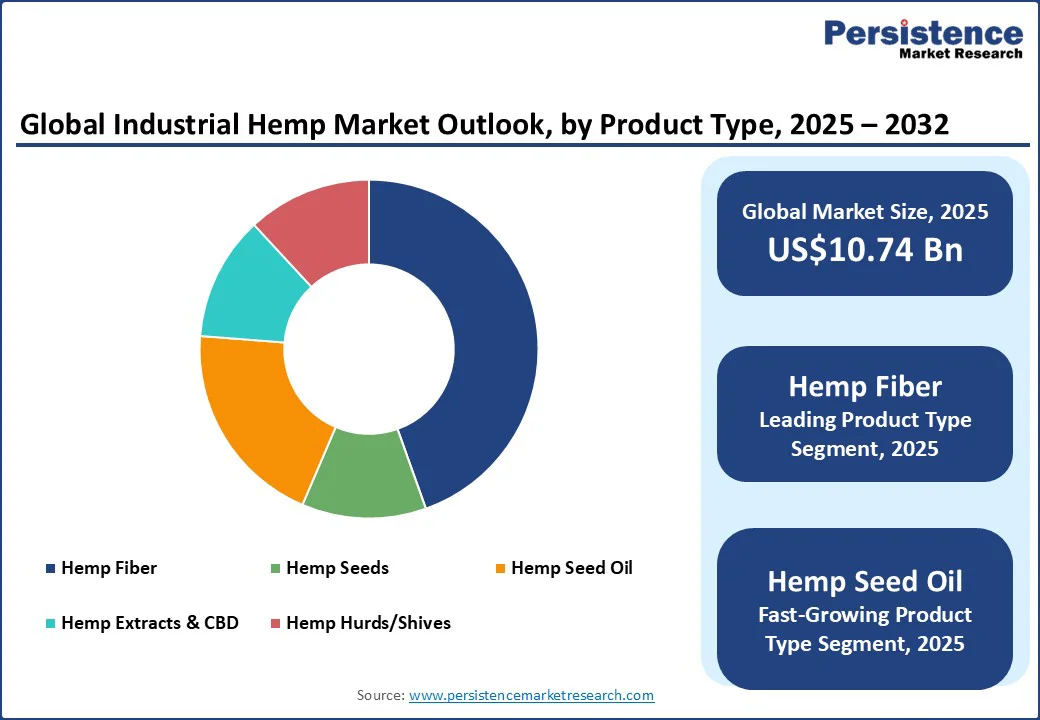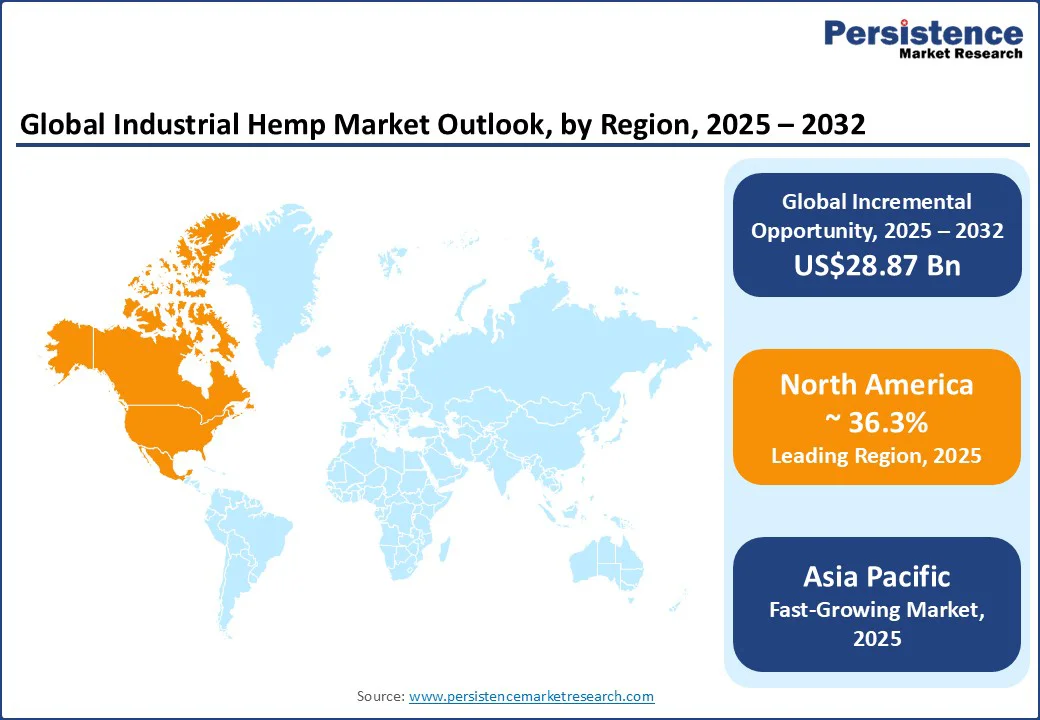ID: PMRREP26017| 191 Pages | 17 Sep 2025 | Format: PDF, Excel, PPT* | Food and Beverages

The global industrial hemp market size is likely to be valued at US$ 10.7 Bn in 2025 and is expected to reach US$ 39.6 Bn by 2032, growing at a CAGR of 20.5% during the forecast period from 2025 to 2032, driven by increasing demand across diverse industries, including textiles, food and beverages, personal care, construction, and bio-composites.
Key Industry Highlights:

| Global Market Attribute | Key Insights |
|---|---|
| Industrial Hemp Market Size (2025E) | US$ 10.7 Bn |
| Market Value Forecast (2032F) | US$ 39.6 Bn |
| Projected Growth (CAGR 2025 to 2032) | 20.5% |
| Historical Market Growth (CAGR 2019 to 2024) | 15.8% |
The industrial hemp market is gaining strong traction from the growing use of hemp-based biodegradable packaging and automotive-grade hemp composites. Hemp-derived bioplastics are being adopted as eco-friendly alternatives to petroleum-based plastics in food packaging, films, and containers.
At the same time, global automakers such as BMW, Mercedes-Benz, and Volkswagen are increasingly integrating hemp-reinforced interior panels and lightweight composites in vehicle design to reduce carbon footprint and improve fuel efficiency. This dual push from packaging sustainability and automotive innovation is creating a clear pathway for hemp’s large-scale adoption in high-value industries.
Another key driver is the rise of carbon-negative hempcrete in sustainable construction and the growing popularity of hemp protein in functional foods. Hempcrete offers natural insulation, mold resistance, and the ability to absorb more CO? than it emits, making it the preferred material for green building projects.
Hemp protein, recognized for its rich amino acid profile and allergen-free properties, is carving a niche in the plant-based nutrition segment. Its application in vegan, clean-label, and nutraceutical products is accelerating demand, particularly among health-conscious consumers looking for high-quality alternatives to soy or dairy proteins.
One of the biggest restraints for the industrial hemp market is the lack of decortication infrastructure, which is critical for separating hemp stalks into usable fiber and hurds. In many regions, especially North America, large-scale primary processing facilities are still absent, creating a bottleneck.
Farmers hesitate to expand hemp cultivation without reliable buyers and processors, while investors are reluctant to build decortication plants without a consistent raw material supply. This supply chain gap slows market scalability, creates price volatility for hemp fiber, and discourages long-term partnerships between growers and end-use industries.
Another challenge lies in the inefficiencies of hemp pulp in paper production. Unlike wood, where nearly the entire raw material can be processed into pulp, only about a quarter of the hemp stalk (the outer bast) is suitable for high-quality paper.
This low utilization rate, combined with outdated processing methods and higher manual handling requirements, makes hemp paper significantly more expensive, often four to six times the cost of wood pulp paper. As a result, hemp paper remains confined to specialty uses such as banknotes, archival materials, and technical filters, limiting its potential to compete in mainstream paper markets.
A major opportunity for the industrial hemp market lies in the development of hemp-derived nanocellulose for high-strength composites. This advanced material is explored for use in lightweight automotive components, durable sporting goods, and high-barrier packaging films, offering a more sustainable alternative to synthetic fibers.
Innovations in long-fiber hemp for circular textile supply chains are creating momentum for hemp-cotton blends and traceable, eco-friendly fabrics. With fashion and apparel brands under pressure to meet sustainability goals, hemp-based textiles present a premium growth opportunity for processors that can supply consistent, high-quality fibers.
Another promising area is the valorization of hemp by-products such as hurds and seeds. The use of hemp hurd biochar in soil carbon sequestration and carbon-negative hempcrete in green construction is transforming low-value residues into climate-positive products.
Demand for hemp seed protein isolate in sports nutrition and functional foods is increasing as health-conscious consumers seek allergen-free, plant-based protein sources. Beyond food, hemp biomass is also converted into activated carbon and filtration media for industrial water treatment, opening lucrative avenues in technical applications where performance and sustainability are equally valued.
Hemp fiber is projected to dominate representing around 45% of the global revenue in 2025. Its dominance comes from its versatility, used in textiles, specialty papers, bioplastics, automotive composites, and even eco-friendly construction materials.
With industries under pressure to reduce reliance on synthetic fibers, hemp fiber has become a preferred alternative due to its strength, biodegradability, and sustainability profile. For instance, leading automakers such as BMW and Mercedes-Benz are integrating hemp fiber composites into car interiors, underscoring wide industrial acceptance.
The fastest-growing product segment is hemp seed oil, which is projected to expand at a high CAGR over the forecast period. Hemp seed oil’s nutritional richness, packed with omega-3 and omega-6 fatty acids, complete amino acids, and bioactive compounds, has boosted its use in dietary supplements, functional foods, and skincare products.
Demand is especially strong in the wellness and personal care industries, where natural, plant-based oils are gaining ground over synthetic alternatives.
The food & beverages segment is expected to lead with a share of around 48% in 2025. Hemp seeds and oils are increasingly incorporated into plant-based milk, protein powders, energy bars, and functional beverages. The growth of the vegan and clean-label movement has positioned hemp as a highly attractive ingredient due to its nutritional density and allergen-free properties.
For example, hemp-based milk alternatives are gaining traction in markets including North America and Europe, offering consumers a sustainable substitute for dairy and soy.
The fastest-growing application segment is expected to be pharmaceuticals, particularly those derived from hemp, such as CBD products. With clinical studies highlighting CBD’s potential benefits in conditions such as epilepsy, chronic pain, and anxiety, pharmaceutical companies are actively investing in hemp-based therapeutics.
This trend is being accelerated by growing consumer trust in natural remedies and a global shift toward plant-based medicine. An example is the FDA-approved drug Epidiolex, a CBD formulation for epilepsy, which demonstrates how hemp extracts are moving from wellness supplements into regulated pharmaceutical markets.

North America is likely to dominate, accounting for a share of 36.3% in 2025, with demand strongly centered around hemp seeds and oils for food, beverages, and wellness products. Hemp seeds exclusively account for nearly 61% of the U.S. and Canadian market share, driven by their adoption in protein powders, snacks, and clean-label foods. Consumers are highly aware of nutrition trends, which have accelerated the growth of hemp-based superfoods and functional beverages.
In the U.S., large-scale industrial processing is expanding rapidly. The Spring Hope Hemp Mill in North Carolina, one of the biggest hemp facilities in the country, is equipped with advanced decortication and supercritical CO? extraction technologies to serve industries ranging from textiles to biocomposites.
Meanwhile, the regulatory environment is evolving, and recent debates in Texas around THC-rich hemp products illustrate the challenges and opportunities for state-level reforms. The veto of Senate Bill 3 in 2025, which would have banned such products, has instead pushed regulators to consider more structured frameworks, such as age limits and clearer labeling requirements.
In Canada, hemp has been legally cultivated since 1998, making it a pioneer in the global market. Canada remains the largest exporter of hemp seeds and oilcake to the U.S., reinforcing its leadership in upstream supply. The market is also witnessing innovation in beverages, with companies such as Trulieve, Curaleaf, and Green Thumb introducing hemp-derived THC drinks.
Europe’s hemp market is more diversified, with countries focusing on different end-users ranging from construction to food. In Germany, hemp shives (hurds) dominate, as these are widely used in automotive composites, building insulation, and sustainable packaging. Germany’s hemp market is supported by strong consumer demand for eco-friendly textiles and bioplastics, as well as strict sustainability goals across industries.
Italy is another fast-expanding hub, with policies that actively encourage hemp cultivation. Farmers growing low-THC hemp do not require cultivation licenses, while R&D projects receive subsidies of up to US$700,000 annually. Growers can receive direct per-hectare payments, making hemp an attractive alternative to low-margin crops such as wheat.
Hempcrete, a bio-based building material, is gaining traction in the country, with studies showing its superior thermal insulation compared to traditional bricks, an important advantage in Italy’s energy-conscious construction sector.
Asia Pacific is the fastest-growing market for industrial hemp, supported by large-scale cultivation, competitive production costs, and increasing investment in downstream applications. Hemp fiber accounted for more than 75% of the regional market, highlighting its dominance in textiles, ropes, bioplastics, and eco-friendly packaging. Rising demand for sustainable fabrics and biodegradable materials is expected to sustain strong growth in the coming years.
China leads global production, supplying low-cost hemp fibers and raw materials to domestic and international textile, paper, and biocomposite industries. Its well-established industrial infrastructure allows it to dominate export markets while scaling innovations in bioplastics and construction. India is also emerging as a fast-growing competitor.
Companies such as Bombay Hemp Company and Hemp Foundation are investing heavily in food, textiles, and nutraceutical applications. Coupled with rising consumer interest in plant-based wellness and supportive government initiatives, India is positioning itself as a key player in both domestic and global supply chains.

The global industrial hemp market is moderately fragmented, with a mix of established agribusinesses, specialized hemp processors, and emerging startups competing across different value chains.
Leading players such as Hemp Inc., Ecofibre Ltd., GenCanna, Aurora Cannabis, and HempFlax BV focus on large-scale cultivation, processing technologies, and downstream product innovation to strengthen their positions. Strategic partnerships with food, textile, and personal care companies are common, as they help expand distribution networks and accelerate product commercialization across global markets.
Competition is intensifying in high-growth niches such as hemp-based foods, CBD extracts, and sustainable textiles, where startups and regional firms are challenging established players with differentiated offerings.
For instance, companies in Europe are innovating with hempcrete and biocomposites for construction, while North American brands are leveraging hemp seed oil in clean-label nutrition and skincare. This ongoing wave of product diversification and vertical integration is reshaping the market, pushing companies to focus on cost efficiency, scalability, and regulatory compliance to maintain a competitive edge.
The industrial hemp market is estimated to be at US$10.74 Bn in 2025.
The industrial hemp market is projected to reach US$39.61 Bn by 2032.
Key trends include growing demand for hemp protein in foods, rising use of CBD extracts, adoption of hemp fibers in textiles and automotive, and expansion of hempcrete in construction.
Hemp fiber holds the largest share at 45% by product type, while food & beverages lead the market by application.
The industrial hemp market is set to grow at a CAGR of 20.5% from 2025 to 2032.
Key players include HempFlax BV, Canah International, Ecofibre Ltd., Plains Industrial Hemp Processing Ltd., and Charlotte’s Web Holdings.
| Report Attribute | Details |
|---|---|
| Historical Data/Actuals | 2019 - 2024 |
| Forecast Period | 2025 - 2032 |
| Market Analysis | Value: US$ Bn |
| Geographical Coverage |
|
| Segmental Coverage |
|
| Competitive Analysis |
|
| Report Highlights |
|
By Product Type
By Source
By Application
By Distribution Channel
By Region
Delivery Timelines
For more information on this report and its delivery timelines please get in touch with our sales team.
About Author